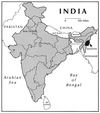Indigenous disseminated Penicillium marneffei infection in the state of Manipur, India: report of four autochthonous cases
- PMID: 10405425
- PMCID: PMC85318
- DOI: 10.1128/JCM.37.8.2699-2702.1999
Indigenous disseminated Penicillium marneffei infection in the state of Manipur, India: report of four autochthonous cases
Abstract
We describe four cases of disseminated infection caused by endemic Penicillium marneffei in human immunodeficiency virus (HIV)-infected patients from the Manipur state of India. The most common clinical features observed were fever, anorexia, weight loss, hepatosplenomegaly, and, more importantly, skin lesions resembling molluscum contagiosum. The diagnosis in each of the four cases was achieved by direct examination of smears, observance of intracellular yeast-like cells multiplying by fission in biopsied tissue from skin lesions, and isolation of the dimorphic P. marneffei in pure culture in each case. In one case, fluorescent antibody studies allowed specific diagnosis. This report documents a new area in which P. marneffei is endemic, located in eastern India, and describes the first occurrence in India of P. marneffei in HIV-infected patients as well as the extension of the areas of P. marneffei endemicity westward to the northeastern state of Manipur.
Figures



Similar articles
-
Disseminated Penicillium marneffei infection among HIV-infected patients in Manipur state, India.J Infect. 2002 Nov;45(4):268-71. doi: 10.1053/jinf.2002.1062. J Infect. 2002. PMID: 12423616
-
Disseminated Penicillium marneffei infection in southeast Asia.Lancet. 1994 Jul 9;344(8915):110-3. doi: 10.1016/s0140-6736(94)91287-4. Lancet. 1994. PMID: 7912350
-
First observation in a non-endemic country (Togo) of Penicillium marneffei infection in a human immunodeficiency virus-infected patient: a case report.BMC Res Notes. 2013 Dec 4;6:506. doi: 10.1186/1756-0500-6-506. BMC Res Notes. 2013. PMID: 24304699 Free PMC article.
-
[HIV-associated Penicillium marneffei infection].Schweiz Med Wochenschr. 1993 Mar 6;123(9):385-90. Schweiz Med Wochenschr. 1993. PMID: 8456267 Review. German.
-
Disseminated Penicillium marneffei infection as an imported disease in HIV-1 infected patients. Description of two cases and a review of the literature.Neth J Med. 1994 Jan;44(1):18-22. Neth J Med. 1994. PMID: 8202201 Review.
Cited by
-
Subcutaneous mycoses: an aetiological study of 15 cases in a tertiary care hospital at Dibrugarh, Assam, northeast India.Mycopathologia. 2015 Jun;179(5-6):425-35. doi: 10.1007/s11046-015-9861-x. Epub 2015 Jan 18. Mycopathologia. 2015. PMID: 25596859
-
Penicillium marneffei infection and recent advances in the epidemiology and molecular biology aspects.Clin Microbiol Rev. 2006 Jan;19(1):95-110. doi: 10.1128/CMR.19.1.95-110.2006. Clin Microbiol Rev. 2006. PMID: 16418525 Free PMC article. Review.
-
Cavitary pulmonary disease.Clin Microbiol Rev. 2008 Apr;21(2):305-33, table of contents. doi: 10.1128/CMR.00060-07. Clin Microbiol Rev. 2008. PMID: 18400799 Free PMC article. Review.
-
The spectrum of clinical and pathological manifestations of AIDS in a consecutive series of 236 autopsied cases in mumbai, India.Patholog Res Int. 2011;2011:547618. doi: 10.4061/2011/547618. Epub 2011 May 23. Patholog Res Int. 2011. PMID: 21660276 Free PMC article.
-
Penicillinosis in a HIV-positive individual.Indian J Sex Transm Dis AIDS. 2012 Jan;33(1):38-40. doi: 10.4103/0253-7184.93819. Indian J Sex Transm Dis AIDS. 2012. PMID: 22529453 Free PMC article.
References
-
- Ajello L, Padhye A A, Sukroongreung S, Nilakul C H, Tantimavanic S. Occurrence of Penicillium marneffei infections among wild bamboo rats in Thailand. Mycopathologia. 1995;131:1–8. - PubMed
-
- Ancelle T, Dupouy-Camet J, Pujol F, Nassif X, Ferradini L, Lapierre J. Un cas de penicilliose disseminee a Penicillium marneffei chez un malade atteint de SIDA. Bull Soc Fr Mycol Med. 1988;17:73–76. - PubMed
-
- Chiewchanvit S, Mahanupab P, Hirunsri P, Vanittanakom N. Cutaneous manifestations of disseminated Penicillium marneffei mycosis in five HIV-infected patients. Mycoses. 1991;34:245–249. - PubMed
-
- Cooper C R, McGinnis M R. Pathology of Penicillium marneffei. An emerging acquired immunodeficiency syndrome-related pathogen. Arch Pathol Lab Med. 1997;121:798–804. - PubMed
-
- Deng Z, Connor D H. Progressive disseminated penicilliosis caused by Penicillium marneffei: report of eight cases and differentiation of the causative organism from Histoplasma capsulatum. Am J Clin Pathol. 1985;84:323–327. - PubMed
Publication types
MeSH terms
LinkOut - more resources
Full Text Sources
Medical

